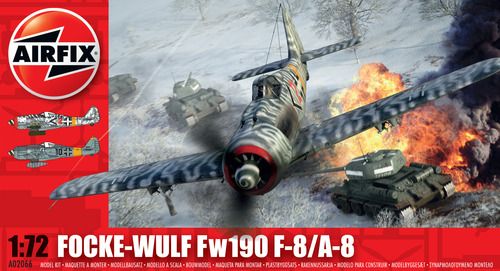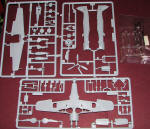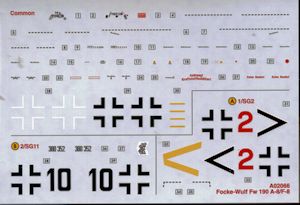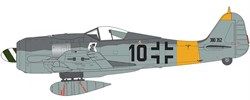
Airfix 1/72 FW-190F-8/A-8
| KIT #: | A02066 |
| PRICE: | $9.25 SRP |
| DECALS: | Two option |
| REVIEWER: | Scott Van Aken |
| NOTES: |

| HISTORY |
The Fw 190 A-8 entered production in February 1944, powered either by the standard BMW 801 D-2 or the 801Q (also known as 801TU). The 801Q/TU, with the "T" signifying a Triebwerksanlage unitized powerplant installation, was a standard 801D with improved, thicker armour on the front annular cowling, which also incorporated the oil tank, upgraded from 6 mm (.24 in) on earlier models to 10 mm (.39 in). Changes introduced in the Fw 190 A-8 also included the C3-injection Erhöhte Notleistung emergency boost system to the fighter variant of the Fw 190 A (a similar system with less power had been fitted to some earlier Jabo variants of the 190 A), raising power to 1,980 PS (1,953 hp, 1,456 kW) for a short time. The Erhöhte Notleistung system operated by spraying additional fuel into the fuel/air mix, cooling it and allowing higher boost pressures to be run, but at the cost of much higher fuel consumption. From the A-8 on, Fw 190s could be fitted with a new paddle-bladed wooden propeller, easily identified by its wide blades with curved tips. A new outwardly bulged main canopy glazing format, more in the manner of a Malcolm hood rather than a bubble canopy, with greatly improved vision sideways and forward, had been developed for the F-2 ground attack model, but was often seen fitted at random on A-8s, F-8s and G-8s. The new canopy included a larger piece of head armour which was supported by reinforced bracing and a large fairing. A new internal fuel tank with a capacity of 115 L (30 US gal) was fitted behind the cockpit, which meant that the radio equipment had to be moved forward to just behind the pilot.
Externally, a large round hatch was incorporated into the lower fuselage to enable the new tank to be installed, and the pilot's oxygen bottles were moved aft and positioned around this hatch. A fuel filler was added to the port side, below the rear canopy and a rectangular radio access hatch was added to starboard. Other changes included an ETC 501 underfuselage rack which was mounted on a lengthened carrier and moved 200 mm (8 in) further forward to help restore the centre of gravity of the aircraft. This fuselage would form the basis for all later variants of the Fw 190 and the Ta 152 series. The Morane "whip" aerial for the Y-Verfahren was fitted as standard under the port wing, just aft of the wheelwell. Nearly a dozen Rüstsätze kits were made available for the A-8, including the famous A-8/R2 and A-8/R8 Sturmbock models. The A-8/R2 replaced the outer wing 20 mm cannon with a 30 mm (1.18 in) MK 108 cannon. The A-8/R8 was similar, but fitted with heavy armour including 30 mm (1.18 in) canopy and windscreen armour and 5 mm (.2 in) cockpit armour. The A-8 was the most numerous of the Fw 190 As, with over 6,655 A-8 airframes produced from March 1944 to May 1945. A-8s were produced by at least eight factories during its lifetime.
The Fw 190 F-8 differed from the A-8 model in having a slightly modified injector on the compressor which allowed for increased performance at lower altitudes for several minutes. The F-8 was also fitted with the improved FuG 16 ZS radio unit, which provided much better communication with ground combat units. Armament of the Fw 190 F-8 was two 20 mm MG 151/20 cannon in the wing roots and two 13 mm (.51 in) MG 131 machine guns above the engine. In the Fw 190 F-8/R1 two ETC 50 bombracks were installed under each wing, capable of holding a 50 kg bombs. In 1945 the ETC 50 was replaced with the ETC 70, capable of holding 70 kg bombs. According to Ministry of Aviation acceptance reports, at least 3,400 F-8s were built, and probably several hundred more were built in December 1944 and from February to May 1945. (Data for these months is missing and probably lost.) Dozens of F-8s served as various testbeds for anti-tank armament, including the WGr.28 280 mm air-to-ground missile, probably based on the projectiles from the Nbw 41 heavy ground-barrage rocket system, and the 88 mm (3.46 in) Panzerschreck 2 rockets, Panzerblitz 1 and R4M rockets.
| THE KIT |
 This
particular kit is an extension of their recent new tool 190A-8, that both
delighted and somewhat frustrated modelers. The molding on this kit is pretty much the same as on
any other current Airfix new tool kit. The engravings are larger than you would
find on a Hasegawa kit for instance, but still well within acceptability for the
vast majority of builders.
This
particular kit is an extension of their recent new tool 190A-8, that both
delighted and somewhat frustrated modelers. The molding on this kit is pretty much the same as on
any other current Airfix new tool kit. The engravings are larger than you would
find on a Hasegawa kit for instance, but still well within acceptability for the
vast majority of builders.
Airfix continues to offer kits with an in-flight option and I have to say that I approve. Having a stand in the kit would be nice, but I can see why they offer it as an additional item as the majority of modelers do not put them in flight. To go with this, Airfix provides a pilot figure which is appreciated by many. Since there is a pilot, there is no seat harness either molded in place or as a decal. Frankly, I'd like to see kits offer a harness decal with their kits as it very much improves the look of the cockpit. Sure, you can get photo etch to install on the seat, but a decal would be much appreciated.
Backing up a bit, the cockpit tub looks like every 190 tub you have ever seen with the area behind the pilot attached. There is a seat, stick and rudder pedals included. There is also detail on the side consoles. Decals are provided for the main instrument panel as there is no other panel detail. A rather neat engineering detail is that the upper wings are molded as a single piece that includes the wheel well. One will have to open holes in the upper and lower wing for the fuselage rack and the gun bulges. There are inserts with the shell ejector openings for the lower wing. This leads me to believe that other variants may be kitted.
Exhaust stubs are provided that fit into the fuselage halves before assembly. There are also separate wing gun inserts. The upper cowling has two pieces one for the forward gun trough and the other the usual gun cover. I should mention that the barrels are molded in the gun cover and the pitot tube is molded into the upper wing. Good luck not breaking the pitot during construction.
Main gear looks like every other good 190 kit and it will be interesting to see how well they lock into place as I see so many 190s built with the gear too straight, some of mine included. Though the kit offers the standard hood, The two markings options are for the later 'blown' hood. The bulged canopy was used starting in January 1945 construction which is after the markings for this kit. The centerline rack is the long version and the kit comes with a nicely done drop tank. A one-piece prop is trapped between the fan assembly and the spinner. The instructions call for the fan assembly to be painted RLM 74 along with the inside of the cowling. Not sure if this is accurate. I have always felt the cowling interior was RLM 02 and the fan assembly was black.
 Now,
what has been added. Well, since the F-8 has no outer wing guns, blanking plates
are provided for that area. There are also outer wing racks, and a centerline
rack. Bombs are provided for all positions, but unless the missions were short,
I'm betting they carried either the large centerline bomb or the smaller wing
mounted versions. The larger housing for the head armor is also part of the kit.
Airfix missed the opportunity to add the Morane antenna and DF loop antenna that
was standard on all late war 190s. Means you will have to either make the bits
or get the Scale Aircraft Conversions metal gear set as it includes these items.
As flimsy as I found the kit gear when I built the A-8, this set is not a bad
idea.
Now,
what has been added. Well, since the F-8 has no outer wing guns, blanking plates
are provided for that area. There are also outer wing racks, and a centerline
rack. Bombs are provided for all positions, but unless the missions were short,
I'm betting they carried either the large centerline bomb or the smaller wing
mounted versions. The larger housing for the head armor is also part of the kit.
Airfix missed the opportunity to add the Morane antenna and DF loop antenna that
was standard on all late war 190s. Means you will have to either make the bits
or get the Scale Aircraft Conversions metal gear set as it includes these items.
As flimsy as I found the kit gear when I built the A-8, this set is not a bad
idea.
 Instructions are well done with the usual pain of dealing with only
Humbrol numbers during construction. Since this is now the more expensive series
two kit, two markings options are provided. one is the box art F-8 from I./SG2
in Hungary during 1945. This is in standard RLM 74/75/76 with white squiggles
over the upper surface. Note that this aircraft does not have the lower landing
Instructions are well done with the usual pain of dealing with only
Humbrol numbers during construction. Since this is now the more expensive series
two kit, two markings options are provided. one is the box art F-8 from I./SG2
in Hungary during 1945. This is in standard RLM 74/75/76 with white squiggles
over the upper surface. Note that this aircraft does not have the lower landing
 gear doors.
The other option is an A-8 with 2./JG 11 in Germany during 1945. Again, standard
RLM 74/75/76 camo. Lots of stencils and no swastika are on the nicely printed sheet. There are
quite a few aftermarket sheets that have been done for the 190A-8 and a few for
the F-8 so finding a
substitute will not be an issue if looking for something else.
gear doors.
The other option is an A-8 with 2./JG 11 in Germany during 1945. Again, standard
RLM 74/75/76 camo. Lots of stencils and no swastika are on the nicely printed sheet. There are
quite a few aftermarket sheets that have been done for the 190A-8 and a few for
the F-8 so finding a
substitute will not be an issue if looking for something else.
| CONCLUSIONS |
I am sure this will be well received by the buying public. The additional sprue and bigger decal sheet pushed this one up a couple of dollars, but if you want a late war FW-190A-8, this is a good kit to get.
| REFERENCES |
http://en.wikipedia.org/wiki/FW-190
Review kit courtesy of your editor
If you would like your product reviewed fairly and fairly quickly, please contact the editor or see other details in the Note to Contributors.
Back to the Previews Index Page